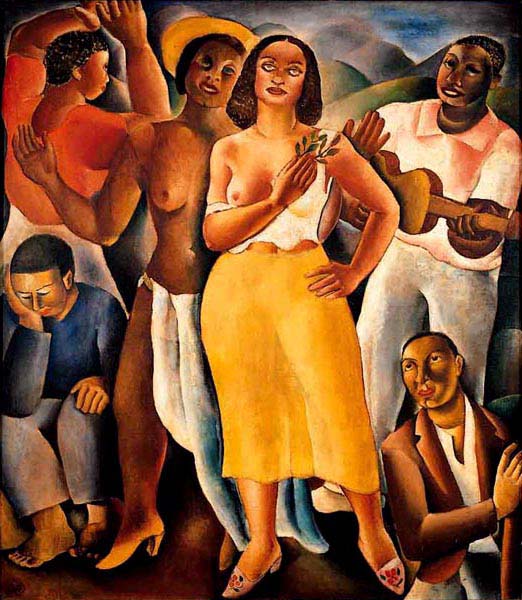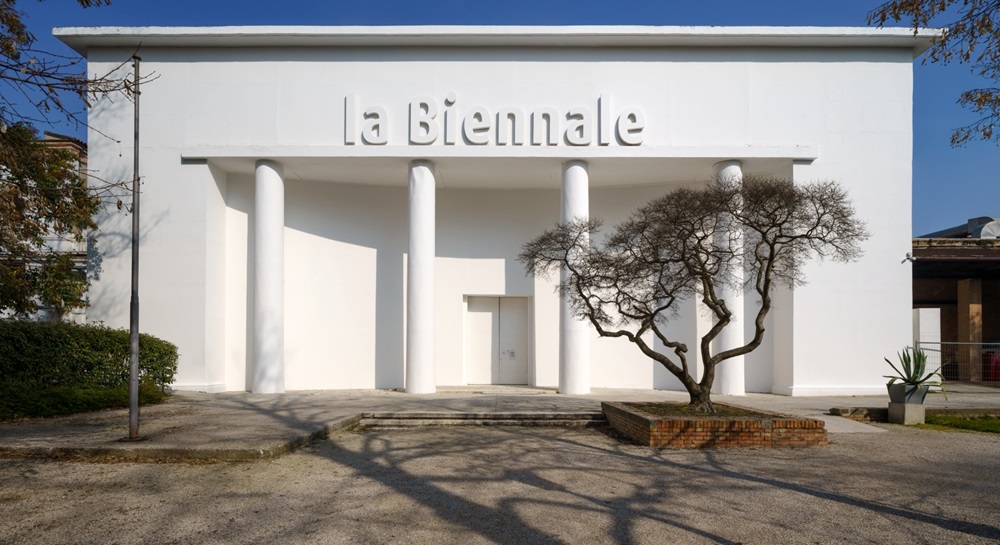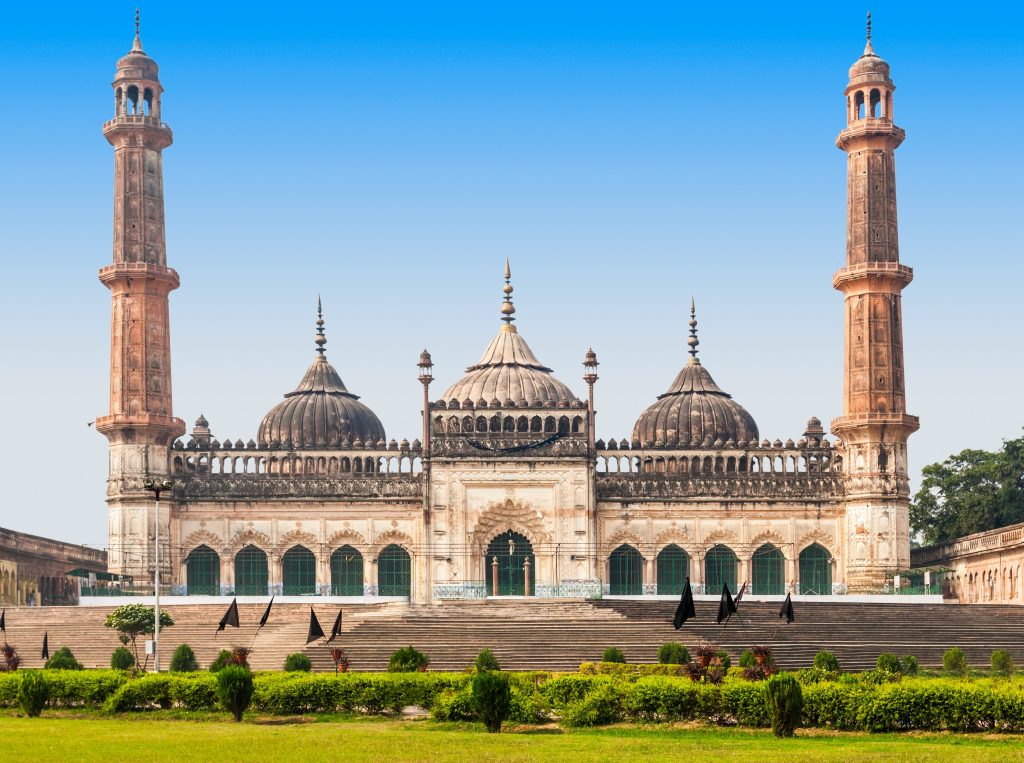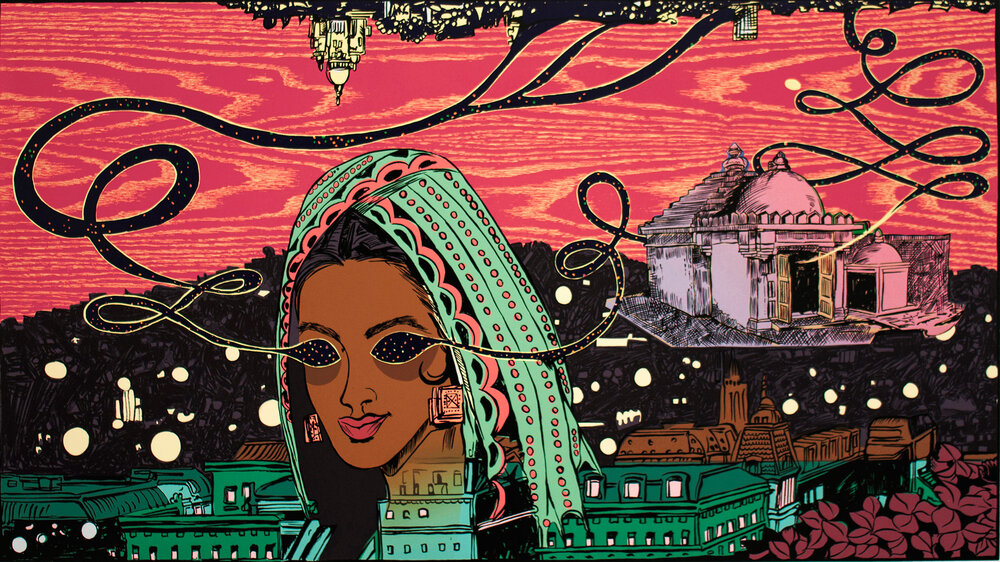The Venice Biennale, renowned for showcasing the pinnacle of contemporary art, has been enriched this year by the powerful presence of three exceptional Brazilian artists: Emiliano Di Cavalcanti, Dalton Paula, and Yêdamaria. Each artist brings a unique perspective to the theme of Afro-Atlantic histories, weaving together cultural narratives that celebrate resilience, identity, and the complexities of the African diaspora in Brazil.
Emiliano Di Cavalcanti
Emiliano Di Cavalcanti, a prodigious artist, began his career at the tender age of eighteen, initially making a name for himself in caricatures and cartoons for various magazines and newspapers. One of his notable works, “Três Mulatas (Moças do Interior)” (1922), delves into the representation of a quintessentially Brazilian stereotype: the mulata. In Brazil, this term has been historically used in a discriminatory and racist manner to describe people of mixed race.
The painting draws on the classic motif of the Three Graces but subverts it significantly. The composition shows one woman facing away from the other two, each gazing in different directions and avoiding eye contact. This arrangement underscores a stark contrast between their apparent unity and their isolation. The distinctiveness of each figure is further emphasized by the varying skin tones, which stand out against the colours of their dresses.

As with many of Di Cavalcanti’s representations of women from this period, the title “Girls from the Countryside” (Moças do Interior), combined with the simplicity of their attire and the absence of jewellery or other adornments, underscores their modest social origins. This depiction reflects an idealization of the povo (ordinary people) typical of many Brazilian Modernists, who often belonged to more elite social classes.
Through “Três Mulatas,” Di Cavalcanti portrays the individuals’ singularities and shared experiences and critiques his time’s social and racial dynamics. The painting is a testament to his nuanced understanding of Brazilian society and his ability to capture its complexities on canvas.
Dalton Paula
Dalton Paula, a multifaceted artist whose oeuvre spans painting, installation, performance art, photography, video, and the manufacture of objects, is presenting his work for the first time at Biennale Arte. Paula’s latest series, Full-Body Portraits (2023-24), comprises sixteen paintings and represents a continuation of the investigation he has been pursuing since the Afro-Atlantic Histories (2018) exhibition at the Museu de Arte de São Paulo.
Dalton Paula, a multifaceted artist whose oeuvre spans painting, installation, performance art, photography, video, and the manufacture of objects, is presenting his work for the first time at Biennale Arte. Paula’s latest series, Full-Body Portraits (2023-24), comprises sixteen paintings and represents a continuation of the investigation he has been pursuing since the Afro-Atlantic Histories (2018) exhibition at the Museu de Arte de São Paulo.

In Full-Body Portraits, Paula delves into the narratives of historical figures of African descent who played pivotal roles in anti-slavery resistance movements in Brazil. These figures include notable leaders such as Chico Rei, Zeferina, and Ventura Mina. Each subject is depicted on large-scale bipartite canvases, a stylistic choice that symbolizes bridging memories and histories through its inherent gap.
This innovative composition creates a dialogue between the landscape and background, characterized by an almost monochromatic relationship that harkens back to the scenographic setups of late nineteenth- and early twentieth-century photography studios. Paula integrates scenographic objects in this series, such as glasses, rocks, chairs, flags, columns, curtains, stairs, and wands. These elements are not merely decorative but serve a critical and symbolic function, highlighting the intricate relationships between image, memory, and power.
Paula’s work in Full-Body Portraits continues his exploration of historical and cultural identity, bringing to the fore the stories of resilience and leadership in the African diaspora. His use of large-scale canvases and evocative objects creates a powerful visual narrative that invites viewers to reflect on the complex interplay of history and memory.
Dalton Paula’s debut at Biennale Arte marks a significant moment in his career, as he brings these powerful and poignant stories to an international stage. His work not only honours the legacy of anti-slavery resistance leaders but also challenges contemporary audiences to engage with the enduring impact of these histories.
Yêdamaria
For the first time, the evocative works of Yêdamaria grace the halls of Biennale Arte, bringing a rich tapestry of cultural and personal symbolism to an international audience. Renowned for her vibrant production in painting, collage, and engraving, Yêdamaria thematically explores still lifes that intertwine motifs from her daily life, Afro-religious deities, the seascape of Salvador – the capital of Bahia, Brazil – and nods to Black and feminist movements.
One of the highlights of this exhibition is her self-portrait, Proteção de Yemanjá (1978). This piece is a profound amalgamation of traditional and imaginative portraiture, creating a striking visual and emotional impact. The canvas is dominated by her serene, symmetrical face, centred and clad in a pink coat that sharply contrasts with the predominant blue of the background. This choice of colours not only captures attention but also evokes a sense of calm and introspection.

Behind Yêdamaria’s central figure, the composition unfolds with a fence, leading the viewer’s eye to a boat set against a solid blue backdrop. This blue suggests the sea and the sky, creating a seamless transition between architectural space and natural landscape. This juxtaposition highlights the artist’s ability to blend different elements into a cohesive and thought-provoking narrative.
A notable feature of this work is the turban on Yêdamaria’s head, where an intricate play of textured and solid colours takes place. This turban is a focal point of the painting, presenting an alternation that sometimes suggests two figures flanking a central red star and, at other times, the image of two mermaids. With their fishtails and long hair, these mermaids are evocative of Yemanjá, the orisha (a Yoruba deity) of the seas, which the work’s title references. The ambiguity of whether these mermaids are a print on the turban or a representation of a psychic projection adds a layer of depth, inviting viewers to ponder the inner workings of the artist’s mind.
Proteção de Yemanjá not only portrays Yêdamaria’s physical likeness but also serves as a window into her spiritual and cultural identity. Yemanjá, an influential figure in Afro-Brazilian religion, underscores the artist’s connection to her heritage and the spiritual world. This connection is further emphasized through the serene and powerful depiction of her face, which exudes a sense of protection and reverence.
Yêdamaria’s work at Biennale Arte uniquely explores personal and cultural identity, seamlessly blending everyday life with spiritual symbolism. Her ability to capture complex emotions and themes in her artwork allows viewers to engage with the multifaceted narratives she presents. The debut of Yêdamaria’s work at Biennale Arte is a significant milestone, showcasing her exceptional talent and the profound depth of her artistic vision. Through Proteção de Yemanjá, she invites us to delve into a vibrant world where the boundaries between the real and the imaginary blur, offering a poignant commentary on identity, heritage, and the power of art to convey the most intimate aspects of human experience.

Jain Syriac Babu is a Kerala-born, Italy-based theatre artist and art enthusiast.





